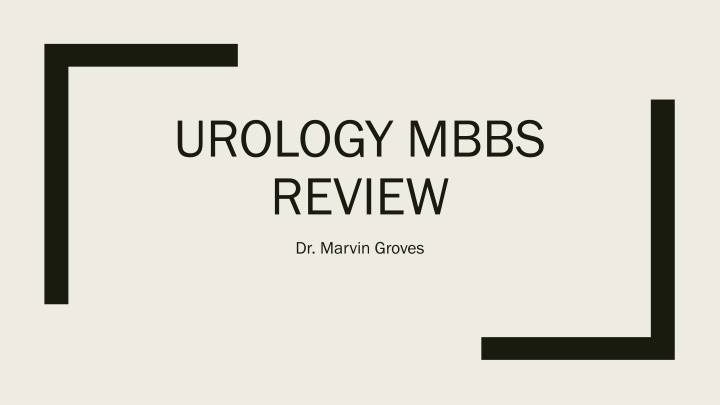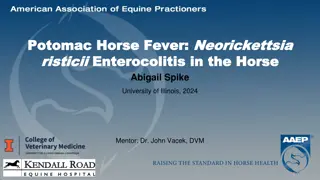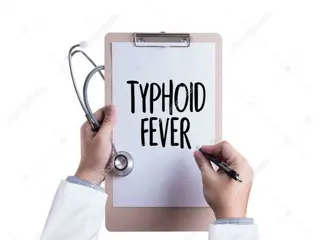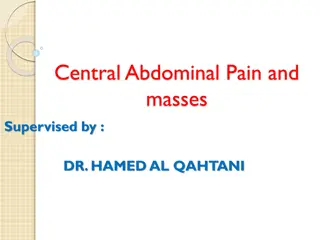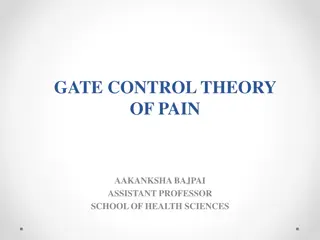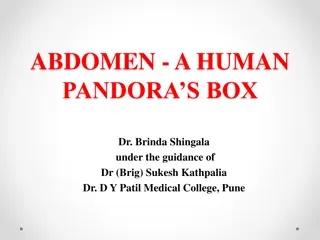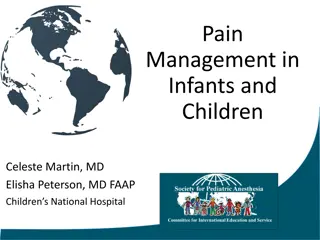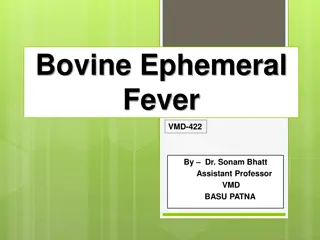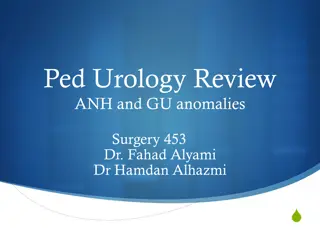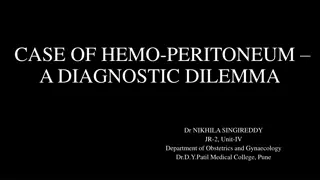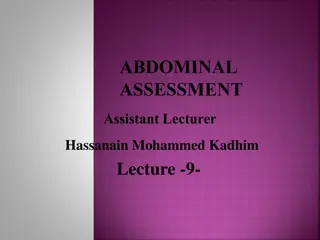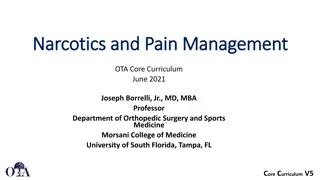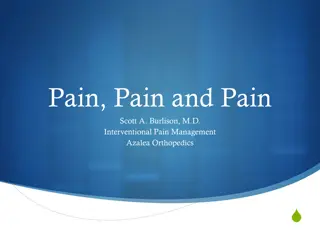Case Review: Diagnostic Dilemma in Urology - Management Approach for a Patient with Abdominal Pain and Fever
A 58-year-old man with a history of diabetes and hypertension presents with fever and abdominal pain, raising multiple differential diagnoses including symptomatic AAA, pyelonephritis, acute appendicitis, complicated urolithiasis, or diabetic ketoacidosis. The case explores clinical manifestations, examination findings, and appropriate investigations like urine culture, KUB, and CT abdomen. Management strategies for suspected urological conditions are discussed in detail, emphasizing the importance of tailored treatment based on diagnosis.
Download Presentation

Please find below an Image/Link to download the presentation.
The content on the website is provided AS IS for your information and personal use only. It may not be sold, licensed, or shared on other websites without obtaining consent from the author.If you encounter any issues during the download, it is possible that the publisher has removed the file from their server.
You are allowed to download the files provided on this website for personal or commercial use, subject to the condition that they are used lawfully. All files are the property of their respective owners.
The content on the website is provided AS IS for your information and personal use only. It may not be sold, licensed, or shared on other websites without obtaining consent from the author.
E N D
Presentation Transcript
UROLOGY MBBS REVIEW Dr. Marvin Groves
Case 1 58 yro man E.G presented to ER with 1/7 hx of fever and 4/7 hx of abd pain. H/o DM type 2 and HTN. States he had intermittent 8/10 pain to right abdomen, radiating to groin area. Pain is worse at night time and he writhes in pain. He vomited x 2 this AM. Examination reveals he is not peritonitic however has some RT renal angle tenderness. Vitals Temp:101F BP:120/80 RR 22 P 90 GMR 9.7 mmol/L Dipstick: Glucose 2+, Protein trace, Blood 3+, Leu 2+, Nitrites pos, Ketones 1+
Question What is the mostly single likely diagnosis for the patient? A) Symptomatic AAA B) Pyelonephritis C) Acute Appendicitis D) Complicated Urolithiasis E) Diabetic Ketoacidosis
Question What radiologic investigation would be most suitable for this patient? A) Magnetic resonance urogram B) CT Abdomen and Pelvis C) IVP D) Abdominal U/S E) KUB Xray Would you do these investigations as an inpatient or outpatient? Why?
Investigations Specific Urine Cx KUB U/S, Gold standard - CT abd (usually non contrast) Non specific CBC, UnE, Urine dipstick*
NC-CT Diagnosis Size Location Signs of obstruction Hounsfield unit of stone Internal Structure of stone Skin to stone distance
Question The patient was confirmed to have a 8mm stone at the Pelvi-ureteric junction (Also seen on the scout film) with mild hydronephrosis. Prior to the CT you had started IVF and Abx. Urine cx Results are not yet ready. The What is the best course of action now? A) Continue Abx and discharge in AM B) Hold Abx until urine cx returns C) Continue Abx and stop IVF D) Allow Home as WBC is less than 15 E) Continue Abx and optimize electrolytes Lab results Lab results Hb 13.5 Plt 234 WBC 14.7 Neu 80% Na 145 K 3.4 Cl 109 HCO3 23 Cr 210 Bun 11 RBG 10.5
Management Acute Period Pain (NSAIDs, Opiods) Infection [UTI, Sepsis] Require Abx Empiric then Cx directed Obstruction If septic intervention required
Question What would be best for definitive management of the 8mm stone obstructing at the UPJ? A) Double J stent B) ESWL C) Nephrectomy D) PCNL E) ERCP
Question Which is not a known risk factor for developing Calcium Oxalate stones? A) Hypocitrauria B) Jejuno ileal bypass C) Renal Tubular Acidosis D) Decreased dietary calcium E) Urinary Tomm Horsfall protein
Pathophysiology of stones Most stones are formed from crystallization. Involves supersaturation (then nucleation, growth and aggregation). General risk factors Dehydration Urinary stasis Urinary pH variations
Pathophysiology of stones Main types of stones: Formation depends on type of stone Calcium Oxalate stone risk factors Increased Ca2+ in urine and blood Increased Oxalate in urine: Dietary, enteric etc Hypocitraturia: Idiopathic, Diet, RTA, Hypokalemia Ca Phos stone risk factors pH (RTA 1), Struvite stones risk factors (Ammonium Phos) Repeated UTI. Struvite stones form in alkali urine, urea splitting organism (Proteus, Pseudomonas, Klebsiella, and Staphylococcus spp. ) Cystine stone risk factors: Genetic Uric acid stone risk factors: Metabolic eg Gout.
Question A Constable was shot in the scrotum by a his own firearm that accidentally discharged. Pt complained of pain to the Lt testes, and swelling was noted. Ultrasound reveal a heterogeneous Lt testes with breach of the tunica albuginea. What is the most appropriate management step? A. Exploration of the testes and attempt repair B. Confirm testicular rupture with CT C. Ice pack with compressive bandage and Abx D. Orchiectomy to prevent loss of contralateral testes E. Confirm testicular rupture with MRI
Testicular Rupture Testicular rupture is breach of tunica albuginea secondary to trauma. Clinical exam accompanied with U/S makes the diagnosis. Early exploration (Ordinarily within 72hrs) and repair is recommended. Orchidectomy is performed when repair is not possible. Conservative management is associated with poorer outcomes than early exploration.
Question A. Testicular Torsion F. G. H. I. J. Prehn s sign Bell Clapper deformity Berchet s disease Mumps Rovsing s sign K. L. M. Epididymo orchitis N. Nux Amatoris O. Double epididymis Appendix testes torsion Testicular cancer B. Coxsackie C. TB D. Communicating hydrocele 1. Pain relief on elevating the testes is known as? 2. Anatomic abnormality predisposing patients to testicular torsion? 3. Blue dot sign is associated with? 4. Condition causing testicular pain and parotitis?
Question 17 yro male S.P was playing football this AM when he noted 7/10 cramping pain to the Rt scrotum. He went home and the pain worsened to 9/10, pt had vomited x 2 and decided to present to AnE. At the emergency room pt was examined and found to have a high riding, tender Rt hemiscrotum. What else is likely to be present on physical exam? A. Pain relief on elevating the scrotum B. Absent cremaster reflex C. A blue dot on RT testes D. RT testes with bag of worms appearance
Testicular torsion SURGICAL EMERGENCY Pt requires surgical management within 6hrs. Occurs when the vascular pedicle of testes twist around on itself and blood flow is compromised. Usually occurs in young males. Usually presents with very tender scrotum, often high riding, swollen, absent cremasteric reflex, occasionally horizontal lying testes. Pain worsens with elevation. Can have associated nausea/vomiting, fever, abdominal pain. Can have intermittent or spontaneous torsion.
Testicular torsion U/S is the investigation of choice. Confident clinically diagnosed torsion should not be delayed by investigations.
Question A 51yro male S.J presented with severe lower abdominal pain and dullness to percussion to the suprapubic region. Pt had history of dribbling and hesitancy with nil passage since last PM. Nil recent surgery done. What is the next most appropriate step? A. Insert Jaques catheter B. Abdominal ultrasound C. Immediate exploratory laparotomy D. Insert urethral Foley catheter and monitor urine output E. Suprapubic catheterization
Pt drained 600cc of blood tinged urine stat post insertion of the catheter. What subsequent drainage would be considered life threatening if nil intervention was attempted? A. 1900cc/24hrs B. 300cc/hr in the first 5 hrs C. 400cc/3hrs for the first 3 hrs D. 2000cc/24hrs
Question 65yro female T.S with history of DM foot presents to A&E for another episode of infection to RT foot. During full examination patient was noted to have a palpable mass arising from the pelvis, which was dull to percussion. Pt did not complain of pain. Patient states she still passes urine though involuntarily. What test would be least helpful in her management? HTLV-1 HbA1c PSA D. B12 levels E. Abdominal U/S A. B. C.
Question A 4yr boy Y.L had recently had his phimosis reduced manually by his parents, the foreskin had then become swollen and formed a ring around the glans penis. Patient complains of pain and swelling, what is your next best step? A. B. C. D. Electrostimulation of prepuce E. Attempt manual reduction with fingers Emergency circumcision Attempt dorsal slit of prepuce Utilize Young s method
Question 35yro woman E.T was in an altercation with another female. During the altercation she was kicked numerous times in the face, chest and abdomen. She presented to AnE with numerous ecchymosis to the face, chest, posterior abdomen and pain to the right chest. Xrays revealed a RT anterior 5th rib fracture along with the right 12th rib and soft tissue swelling to face. What is the role of urine dipstick for this patient?
Question What is true concerning priapism? A. High flow priapism is more common than low flow priapism B. It is due to prolonged engorgement of the bulbospongiosum C. Low flow priapism is a urological emergency D. Distal shunts have higher risk of ED than proximal shunts E. Sildenafil is contraindicated in stuttering priapism
Priapism Persistent penile engorgement for >4hrs (unrelated to sexual desire/stimulation) Low flow priapism accounts for ~ 95% of cases. This is a urological emergency Vaso occlusive event, associated with low arterial flow. After 24 can lead to thrombosis and necrosis 2ndry to sinusoidal destruction.
Priapism Icing, Aspiration (30mls until bright red blood returns) Intracorporeal alpha 1 agonist. Phenyl ephrine up to 1 hour After 1 hour if attempts are unsuccessful then shunts with corpora and glans made. High flow priapism is usually 2ndry to trauma, creating an arterial fistula with sinusoids. Stuttering is self limiting episodes similar to low flow priapism In HbSS ensure pain relief and hydration
Penile fracture Occurs when trauma occurs to the erect penis associated with swelling and detumesence. Pt describes pop Aubergine sign Eggplant appearance 2ndry to extra tunica albuginae haemorrhage Early exploration and evacuation of haemotoma is associated with better outcomes. Conservative treatment can result in Peyronie s disease and ED. MRI and US can aid if diagnosis is in doubt Urethral damage can occur 30%, and should be investigated if suspected.
50yr male F.V presented to his GP complaining of blood in the urine. He had nil other complains. He states he has HTN however is controlled on Amlodipine 10mg po od. He stated he once worked for a textile company. What would you describe his hematuria? What differential must be entertained? What investigations Required for haematuria? Is it the same for all types of haematuria? Required for this patient?
Bladder Ca Risk factors Age, Male gender, Genetic, H/o radiation to pelvis Chronic inflammation (Shistosomiasis, recurrent uti, nitrosamines Cyclophasphamide Smoking Occupation: Dyes used in leather and textile, etc) HPV
